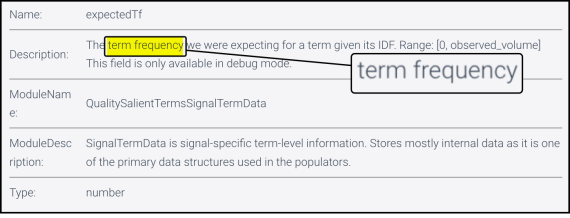Understanding Google’s methods for organizing search results is the first step in optimizing a page’s visibility. Of Google’s roughly 130,000 ranking factors, keyword density is a long-debated metric that resurfaced with the recent algorithm document leak.
The leak suggests that keyword density is likely fundamental to ranking a page on Google’s SERPs.
But first, a word on fundamentals and why they’re important. Reliable, consistent search engine optimization applies the key factors likely to result in higher rankings. Focusing on the fundamentals is both efficient and effective.
In SEO circles, keyword density is called “term frequency.” Some call it “keyword stuffing.” Regardless, the goal is to increase the on-page frequency of the keyword you want to rank for.

Leaked Google algorithm documents name “term frequency” as a ranking factor. Source: “Google Ranking Signals” at DixonJones.com.
‘Skincare’
Consider a highly competitive term such as “skincare.” Here are the top five ranking domains for “skincare” and the number of times that word appears in the HTML (in Chrome, go to “View” > “Developer” > “View Source”):
- Sephora.com – 762
- TheOutset.com – 165
- Fresh.com – 607
- CreamySkincare.com – 182
- Skinbetter.com – 596
The Outset and Creamy Skincare achieved top-five rankings despite relatively fewer keyword mentions, confirming the many ways to rank a page. The other three suggest a linear relationship between keyword density and rankings.
According to Search Engine Journal in 2019, when asked if keyword density is a ranking factor, Google spokesperson John Mueller said, “…this is a fairly old metric, and things have evolved quite a bit over the years…there are lots of other metrics as well.”
While confirming alternative metrics, Mueller does not deny that keyword density is a fundamental ranking factor.
Google may use factor diversity to spot and disqualify attempts to manipulate its search algorithms. In other words, keyword stuffing alone doesn’t work on, say, an ecommerce product page. But keyword stuffing in combination with other factors does.
Top Factors
Google’s top 200 ranking metrics are reported daily on Top SEO Factors, developed by Ted Kubaitis, who also makes an SEO analytics tool called Cora.
As of June 17, 2024, Kubaitis’s top three factors are:
- Number of unique latent semantic keywords used [i.e., words related to the target],
- Number of distinct entities used [i.e., an identifiable thing in a database],
- Domain is .com, .net. or .org.
The top two are likely fundamentals, whereas number three is presumably owing to the number of top-level domains using .com, .net, or .org.
“Term frequency” is number 33 on the list — down 18 positions over the last 30 days — but that’s 33 out of 130,000.
The recently leaked Google documents contain many references to “term frequency.” Read it for yourself on a page created by Dixon Jones, a developer who created a tool for researching entities related to target keywords.
The Google leak is documentation only, not source code. Many notes are old with undefined words, ratios, and calculations. Thus the only certainty is Google uses, used, or considered the factors at some point.
Nevertheless, based on the shared testing and knowledge of the SEO community, the leaks reinforce many practices already in place.
For example, searching “term frequency” on Dixon’s site returns six results referencing “Tf,” which the documents define as “term frequency.” These references suggest that keyword density is fundamental to search engine optimization, particularly at the beginning of a document, although “beginning” is undefined.
Moreover, the leak suggests that Google considers the ratio of your keyword to all the other pages on the web that use it. But that is seemingly prohibitively expensive to compute for every search. Keyword density for a single page, however, is not.
It seems difficult, if not impossible, for an algorithm to determine the topical relevance of a page without at least considering keyword density. What’s the alternative for a term such as “computer” without using that term or a synonym a certain number of times?
Wikipedia, which ranks number one for “computer,” includes that word 1,354 times in the page’s HTML, which, again, anyone can see.
Remember, keyword density is one of many factors. Overusing it will not likely increase rankings. But combined with other top factors, it’s likely to increase page rankings, including for ecommerce products.






